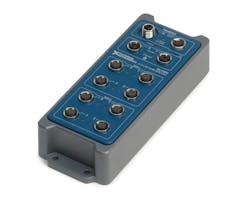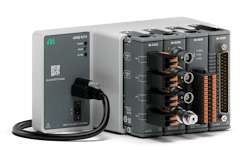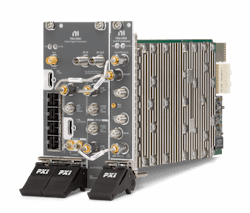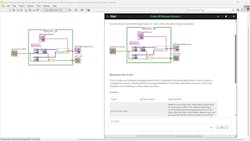Streamlining the Development of Test and Measurement Apps
What you’ll learn:
- What new hardware is available from Emerson’s Test and Measurement group?
- How the Nigel AI Advisor is changing LabVIEW.
I was able to talk with Kevin Schultz, CTO of the Emerson Test & Measurement Group, at the company’s recent NI Connect 2025 conference (watch the video above). Kevin gave a brief introduction on the Nigel AI Advisor for LabVIEW and discussed some of the new test and measurement hardware platforms.
New Rugged Data-Acquisition Tools
One of the newly announced hardware items at NI Connect was the Rugged FieldDAQ (Fig. 1). Contained in an IP67-rated water-proof housing, it’s designed for field deployment.
For the lab, developers can take advantage of the cDAQ-9177 USB-C NI CompactDAQ chassis (Fig. 2). This supports the new connector on the C Series Modules that work with other CompactDAQ chassis. The single USB Type-C connection provides power and control from the host PC that’s typically running LabView. It is available in 1-, 4- and 8-slot versions.
Emerson also delivered an updated NI PXIe-5842 Vector Signal Transceiver (VST3) with a 4-GHz bandwidth option (Fig. 3). A pair of VST3 units can be linked to provide bandwidth support up to 7 GHz. It uses spectrum stitching technology developed by the company.
How Nigel AI Advisor is Changing LabView
Emerson’s Nigel AI Advisor was in beta in 2024. It’s now ready for prime time and available to those with a professional LabVIEW license.
The deployed version of Nigel (Fig. 4) is powered by Microsoft’s Azure OpenAI. It’s integrated with NI LabVIEW and NI TestStand. It has the typical chatbot text prompt interface, but it can be initiated from various places while using the software tools. This makes it easier to provide context to Nigel, simplifying the prompts necessary for it to provide feedback.
Nigel was trained with LabVIEW and Emerson hardware information as well as test and measurement information, so it’s more focused than more general chatbots. It can provide tips and information about LabVIEW graphical programming concepts, as well as find and recommend related LabVIEW virtual instruments (VIs), sample programs, and other details.
Nigel knows about the hundreds of settings in LabVIEW; for hardware platforms, it can show users where and why they’re used. It can also make changes upon request. This includes modifications to VIs in addition to explaining the function and operation even if they weren’t written with any comments. It’s able to generate summary documentation for undocumented code or expand upon existing documentation, too.
About the Author
William G. Wong
Senior Content Director - Electronic Design and Microwaves & RF
I am Editor of Electronic Design focusing on embedded, software, and systems. As Senior Content Director, I also manage Microwaves & RF and I work with a great team of editors to provide engineers, programmers, developers and technical managers with interesting and useful articles and videos on a regular basis. Check out our free newsletters to see the latest content.
You can send press releases for new products for possible coverage on the website. I am also interested in receiving contributed articles for publishing on our website. Use our template and send to me along with a signed release form.
Check out my blog, AltEmbedded on Electronic Design, as well as his latest articles on this site that are listed below.
You can visit my social media via these links:
- AltEmbedded on Electronic Design
- Bill Wong on Facebook
- @AltEmbedded on Twitter
- Bill Wong on LinkedIn
I earned a Bachelor of Electrical Engineering at the Georgia Institute of Technology and a Masters in Computer Science from Rutgers University. I still do a bit of programming using everything from C and C++ to Rust and Ada/SPARK. I do a bit of PHP programming for Drupal websites. I have posted a few Drupal modules.
I still get a hand on software and electronic hardware. Some of this can be found on our Kit Close-Up video series. You can also see me on many of our TechXchange Talk videos. I am interested in a range of projects from robotics to artificial intelligence.




